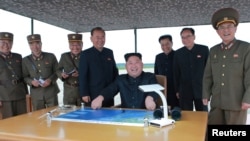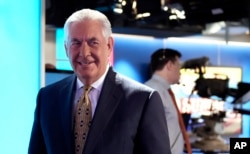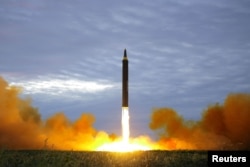North Korea's test-firing of yet another ballistic missile proves that the Kim Jong Un regime has no intention of slowing down its nuclear weapons ambitions, analysts say, and that attitude effectively thwarts — at least for now — any chance of dialogue between the United States and Pyongyang.
Launched from the vicinity of Sunan Air Base, near the North Korean capital, the missile traveled 2,700 kilometers (1,700 miles) early Tuesday morning, reaching a maximum altitude of roughly 550 kilometers (340 miles). It set off alarms in Japan as it passed over the northern island of Hokkaido and landed in the Pacific Ocean after a flight of 14 minutes. The Pentagon assessed the missile was an intermediate-range ballistic missile, the Hwasong-12, the same weapon that the Kim regime has been promising to fire into waters near the U.S. territory of Guam.
It did not pose a threat to North America or to Guam, the Pentagon said, but added: “We continue to monitor North Korea's actions closely.”
“Had they launched [it] toward Guam, that would have been not quite to Guam but pretty close,” said David Maxwell, associate director of Georgetown University's Center for Security Studies. He told VOA Korean: “I think they are trying to demonstrate that capability.”
Change in direction
The latest missile firing came just days after Secretary of State Rex Tillerson had welcomed the Kim Jong Un regime’s “level of restraint” since Aug. 5, when the U.N. Security Council unanimously agreed to impose new sanctions on Pyongyang. The sanctions are intended to reduce North Korea's export revenues from sales of coal, iron ore and seafood, possibly making a billion-dollar dent in the regime's hard-currency earnings.
A pause in missile launches by North Korea could point toward possible dialogue with the U.S., Tillerson said, adding, “We need to see more on their part.” Seoul's Unification Ministry echoed his statement but went further and said it was considering sending an envoy to Pyongyang.
North Korea fired three short-range missiles early Saturday, apparently as a gesture of defiance against joint U.S.-South Korean military exercises that had just begun. Then came the larger rocket's flight over Japan early Tuesday, which triggered alarms in many capitals.
North Korea shows progress
At the White House, President Donald Trump issued a statement denouncing North Korea: “This regime has signaled its contempt for its neighbors, for all members of the United Nations, and for minimum standards of acceptable international behavior. Threatening and destabilizing actions only increase the North Korean regime's isolation in the region and among all nations of the world. All options are on the table.”
Analysts said the North Korean missile program continues to show progress on Pyongyang's announced goal of developing a long-range, nuclear-tipped missile that could reach the U.S. mainland. But they noted Tuesday’s launch was more of a political gesture: a calculated move to signal to Washington and its allies that the Kim regime is not interested in diplomacy and does not intend to suspend its weapons tests.
Gary Samore, who worked on arms-control issues under former President Barack Obama, said this week’s missile test was an important political statement from Kim, signaling “he is not intimidated by the U.N. Security Council resolutions [or] by the U.S.-South Korea military exercises.” The annual war games that began last week are due to run until Aug. 31.
“Eventually we will make it back to diplomacy, but at least for the time being, I think the reaction of the U.S. will be to not expect that talks will take place in the near future, and to focus U.S. energy on increasing sanctions,” said Samore, who is now with the Belfer Center for Science and International Affairs at Harvard University.
Prospects for dialog take a hit
Bruce Klingner, northeast Asia analyst at the Heritage Foundation in Washington and a former CIA intelligence analyst, said the message carried by Pyonyang's rocket undercut and set back the prospects for dialog that had been encouraged by suggestions in Washington and Seoul that nuclear talks could resume if the North ceases further provocations.
Georgetown University's Maxwell said the missile launch might have been part of an attempt to stifle implementation of the new restrictions on North Korea by the U.S. and South Korea.
“If North Korea continues these provocations, they are forcing us to react ... and so by reacting to each provocation, we are unable to execute a long-term, holistic, coherent policy,” Maxwell said. “So the North maybe is attempting to keep both South Korea and the U.S. off balance in execution of new policies.”
David Straub, a former U.S. State Department official and a North Korea expert at the Sejong Institute, near Seoul, said North Korea uses the threat that it might use nuclear weapons in an attempt to decouple Washington from Seoul — and eventually Tokyo — so that Pyongyang can “reset the strategic chessboard on the Korean peninsula.”
Jenny Lee contributed to this report which originated on VOA Korean.











